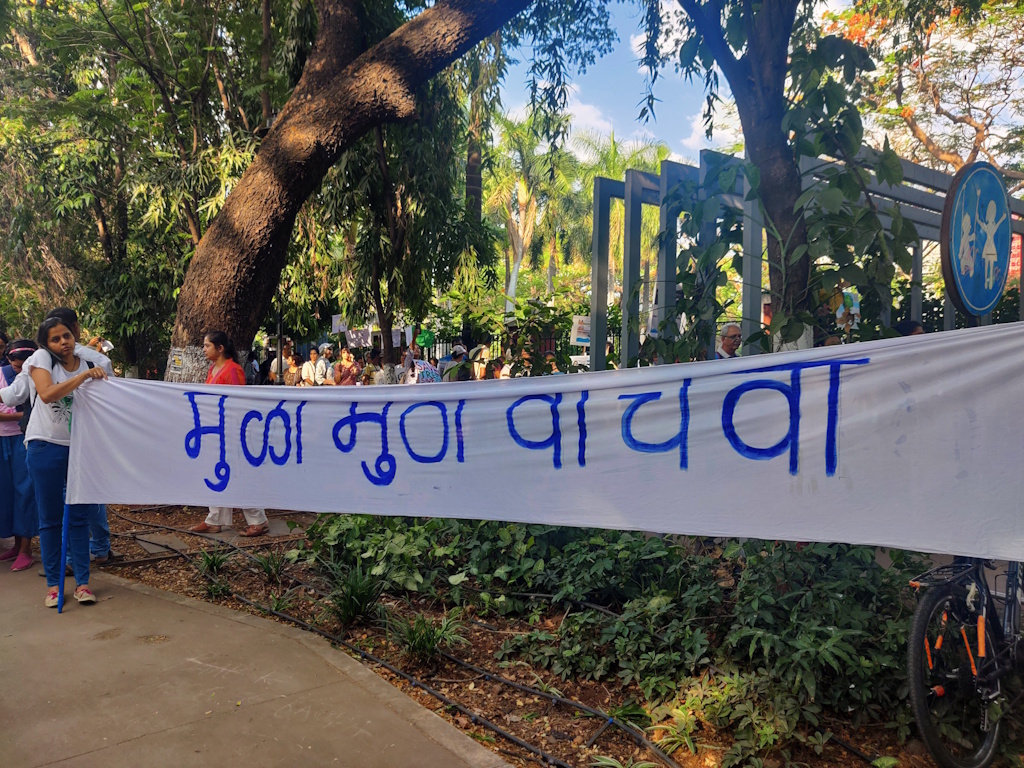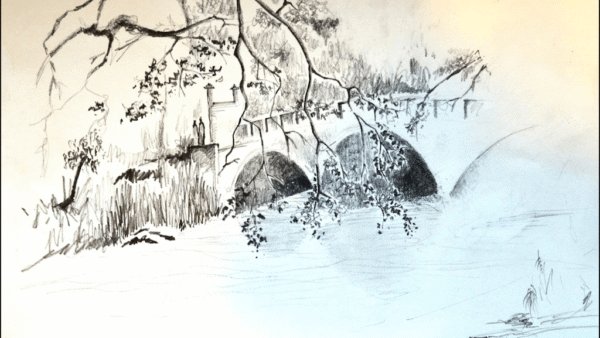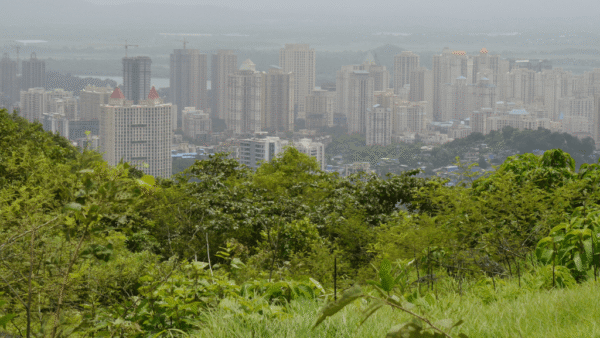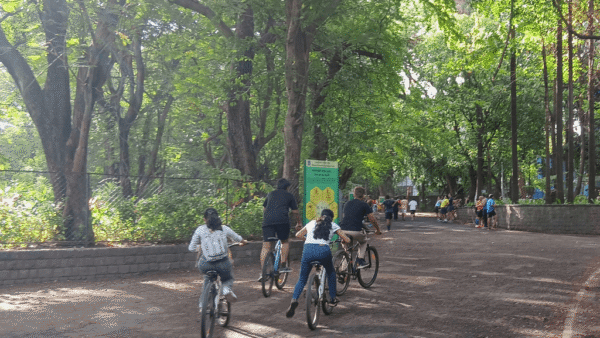In March and April this year, hundreds of Pune residents protested by forming human chains and walking to demand conservation and restoration of the city’s rivers. A lifeline for more than 3 million residents, the Pavana, Mula-Mutha and Indrayani rivers have become polluted over the years because of garbage, untreated sewage and encroachments. The Mula-Mutha riverfront development has intensified the woes. “We do not want riverfront development. We want clean rivers,” demanded the protesters, opposing plans to axe more than 22,000 trees to make way for the project. A total of 240 hectares of green cover is slated to be replaced with concrete embankments.
Environmental activist Sarang Yadwadkar, along with other Pune residents and groups working for the restoration of rivers, has opposed the Rs4,727-crore Pune riverfront development project[1] on the grounds that it will destroy the riverine ecology. They launched ‘Pune Bachva Mohim’[2], demanding to stop the project and save the city from flooding every year. An architect by training, Yadwadkar is now a full-time environmental activist, persistently fighting and questioning rampant illegal construction of unscientific infrastructure and development projects.

Photo: Via X/ @SVYadwadkar
The riverfront development is supposedly for people and the rivers. How will it impact the riverine ecology and people’s connection with rivers?
Five rivers – the Mula, Mutha, Pavana, Ramnadi and Devnadi – enter into the city, merge with each other and flow out as one single river. Ramnadi and Devnadi are smaller rivers but Pavana, Mula and Mutha are relatively larger rivers originating from the Sahyadri range. There is a funnel-like situation. And Pune is at the neck of the funnel.
Besides, these five rivers have seven dams on the immediate upstream within a distance of 25-30 kilometres from Pune. There are four dams on the Mutha at Khadakwasla, Panshet, Varasgaon and Temghar; one dam on Mula River; one on another tributary, Kasar Sai, and one dam on the Pavana. The discharge from these seven dams pass through Pune city. So, water has multiple entries but only one exit.
The funnel-like situation and dams on the upstream make the city highly vulnerable to floods. Pune is one of the most flood-prone cities. In 1997, the immediate upstream dam at Khadakwasla on the Mutha, released around 90,000 cusecs (cubic feet per second) of water. Pune was flooded that day. But, now, the water level in the city reaches the same level even if 50,000 cusecs is released. This is because the riverbed is being pinched. There are innumerable encroachments preventing the free flow of water. The cross-sectional area is being reduced by almost 40 percent, from what I know.

Map: Nikeita Saraf
Without any lateral space, the water is only going to rise. That’s why we are raising objections on the hydraulic aspect. Of course, there are other aspects like destruction of biodiversity, ground water, disruption of aquifers. Pune generates around 1500 MLD (million litres per day) of sewage. The municipal corporation has the capacity to treat only 477 MLD which means not even one third of the sewage generated is treated by the corporation. The remaining sewage goes into the river untreated, polluting Mula-Mutha river, Bhima river on the downstream, and Ujani dam, causing skin diseases, digestive disorders among residents.
Pune’s rivers are going the Sabarmati way. In the Sabarmati riverfront development, there is no Sabarmati water flowing in the river but it is the water borrowed from the Narmada’s canals. It’s stored water in the channel and they call it Sabarmati ‘river’. The Narmada water is Sabarmati, and it is stagnant, not flowing, because of a barrage constructed downstream at Vasna. In Pune too, they have proposed construction of huge barrages. So, the riverfront will be concretised construction along with stagnant ponds; you can imagine the ecological damage.
How did the movement against the riverfront development take shape and how has it sustained?
It started way back in 2012 when a different model of riverfront development was proposed for Pune’s rivers. We filed a petition against it in the National Green Tribunal in 2013. In the same year, the Pune Municipal Corporation withdrew the proposal in the court and the matter was over. Things changed after 2014 when the BJP government came to power. Architect Bimal Patel started sending proposals to different cities for riverfront development.
He submitted a proposal for Pune riverfront development sometime in 2016. After he gave his first presentation before the public and some invitees, we raised objections on certain things but he was unable to give explanations on those issues. Then, the movement against the riverfront development resumed and, subsequently, many individuals and organisations joined us.
Our movement is divided into three independent verticals – legal, political and social — working in tandem but, in a way, also working independently. I am looking into the legal aspects and handling cases filed against the riverfront development. Organisations like Jeevit Nadi and its founder-director Shailaja Deshpande, well-known individuals working in the field of sustainable development like Rajendra Singh of Jalabiradari, Narendra Chugh, Priyadarshini Karve, Jaideep Baphna, Ameet Singh have joined us.
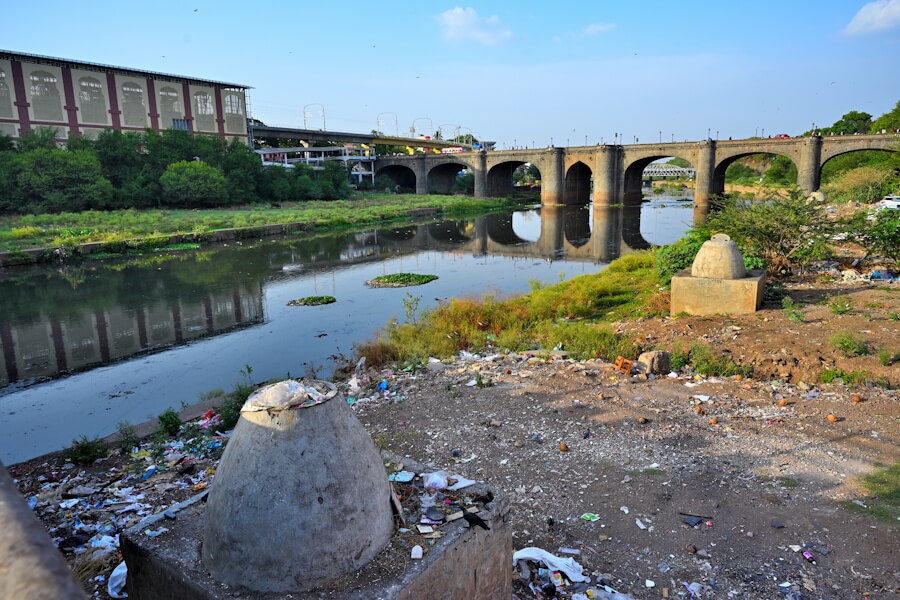
Photo: Wikimedia Commons
Pune has been seeing many instances of flooding in recent times.
Like every human being, every river has its own temperament too — it depends upon the catchment as well as its topography. On the upstream of the city, the Mula-Mutha originates from the Sahyadri range. The upstream catchment is steep which means the surface runoffs are very fast because of the gradient.
As the velocity of the surface runoff is very high, there is hardly any percolation into the ground, the river has increased and faster surface runoffs which ultimately lead to flash floods. Pune has experienced flash floods almost once in every 10 years. Till they enter the city, the rivers are hot-tempered rivers, as I call them. From Pune onwards, their gradient and velocity are relatively reduced.
Would restoring the river’s ecology help? How can this be done?
The most important thing is not to pollute and encroach upon the rivers. I am talking only about the urban stretches. The pollution happens because we release untreated effluents and sewage in the rivers, encroach upon the riverbeds, human activities disturb the ecology on both banks of the rivers and the riverbed too. We don’t have any option but to remove all encroachments. Whether it is Delhi, Pune or Chennai, we must treat the sewage that flows into the rivers. Our policies and facilities to treat the sewage and industrial pollutants is a disastrous failure.
The rule is very simple: Do not dump any pollutants in the rivers, do not encroach upon the rivers, give them their space. That’s more than enough to protect them and their ecology.
How do you see the carrying capacity of rivers flowing in urban areas?
The reason we talk about restoring a river’s capacity is because we have decreased it. We have to repair the damage we have caused. The flood levels in the rivers are rising because of two reasons. Firstly, climate change has been causing annual rainfall levels to increase and the number of rain days to decrease, leading to severe intense rainfalls in shorter times, cloudburst events, and more surface runoffs.
Secondly, because of urbanisation, there is a lot of soil capping and concretisation across the city. There is no open soil for the water to percolate into the ground, ultimately resulting in floods and flash floods. For this purpose, we need to increase the carrying capacity of the rivers just like we increase the carrying capacity of the roads if the volume of traffic increases.

Photo: Wikimedia Commons
But if the flow in the rivers is increasing, why not widen the rivers? Because there’s no space for that. We cannot ‘widen the rivers’ in urban stretches so that the water has more space. At least, we should not encroach upon the rivers and reduce it. I keep saying: minimise concretisation and let the rivers flow freely, give them their space, keep some soil open so that rain water percolates into the ground.
How has the riverfront development impacted the river ecology and people’s connection with the river?
Only 30 percent of the sewage generated in Pune is treated by sewage treatment plants. So, in the last two decades or so, the rivers have been flowing in highly polluted conditions because of which people have lost the connection with the river. Pune residents have a very good connection with the hills in the city. Thousands of people go for morning walks to the hills. But hardly anyone goes along the river for a walk or to spend time there because the rivers are highly polluted and stink because of untreated sewage and industrial effluents. People have already lost the connection with rivers.
The riverfront development project claims to re-establish that connection but the government is not addressing the fundamental issue of pollution in the river. The project is not spending a single rupee to address pollution, they are spending only on beautification. Secondly, Pune has a very good green cover. The riverfront development proposes to fell 22,150 trees – these are only the big trees, not small shrubs and other vegetation. This is the official figure but the actual number of trees felled may be more than that.

Photo: Wikimedia Commons
Then, they are reclaiming the floodplains by concretisation, dumping debris and soil, increasing the height of the floodplains by 15-20 feet, constructing concrete or stone embankments, and channelising the river. So the natural ecology, whether of birds or aquatic animals or insects, will be completely destroyed. The birds have gone, there are no insects. I stay right on the banks of Mutha river, so I know the biodiversity that exists. From morning to night, I hear sounds of different birds, see peacocks, pythons, mongooses among other creatures, but all this will be gone when the riverfront development is complete.
How do we reconnect people to the river?
Fundamentally, people in all civilisations, not only in India but all across the world have evolved along rivers because human beings need water. There is a perpetual connection between water and human beings, but that has been harmed. Just let the rivers flow freely and don’t pollute them. We need to clean them, not encroach, not exploit the floodplains and riverbed for construction of buildings and food plazas.
Rivers also have emotions like human beings; we need to understand that. Just as our emotions sometimes flow high, similarly the water in the river also rises because of different reasons and it has to have the space to flow. Rivers are mothers of our civilisation. If our mother is seriously ill and therefore not looking good, should we take her to a beauty parlour or to a doctor?
Cover photo: Wikimedia Commons

